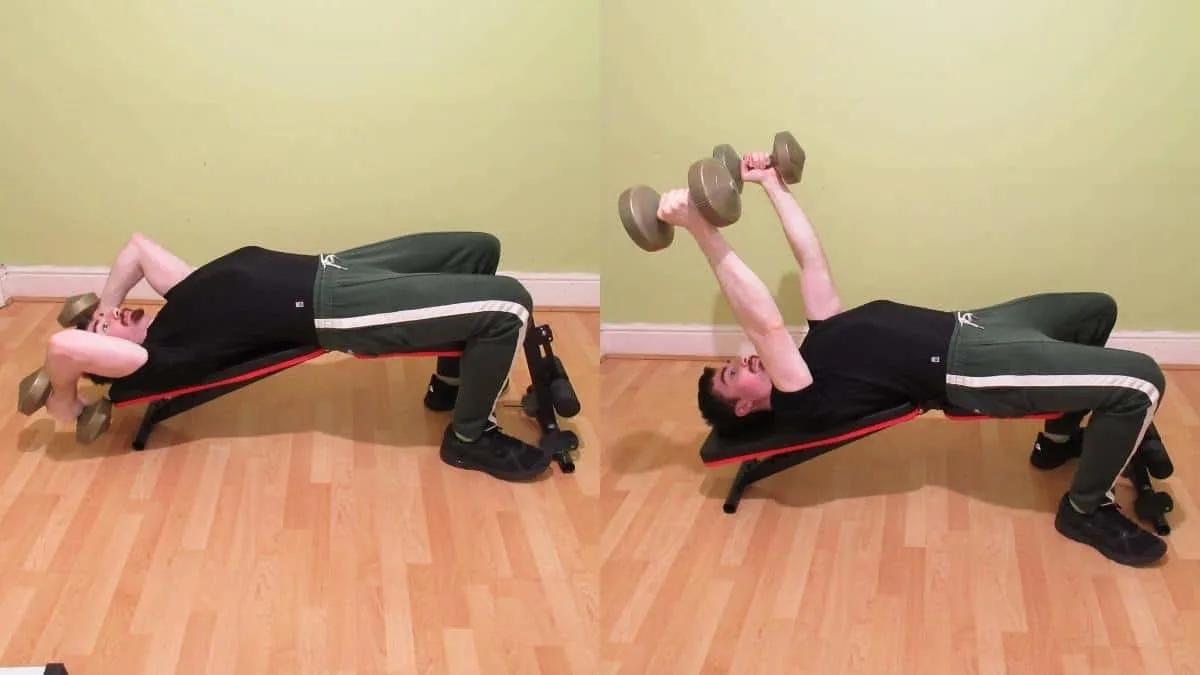The decline dumbbell triceps extension is an underrated mass-building exercise that’s seldom performed outside of exercise tutorials like the one you’re about to read.
Most lifters, it seems to me, just perform the flat lying dumbbell tricep extension because it requires marginally less setup time than the decline version.
Yet, the decline tricep extension holds some distinct advantages over its flat bench counterpart that no serious bodybuilding enthusiast should ignore.
This detailed guide discusses those benefits (and the drawbacks, too) and shows you an additional five variations of decline triceps extensions that you can perform to add variety to your workout routine.
Related: Cross body dumbbell tricep extension
Decline dumbbell triceps extension exercise details
- Also Known As: Decline DB tricep extension
- Main Muscles: Triceps
- Exercise Type: Strength
- Exercise Mechanics: Isolation
- Difficulty Level: Intermediate
- Equipment Needed: Dumbbells, decline bench
How to do a decline triceps extension
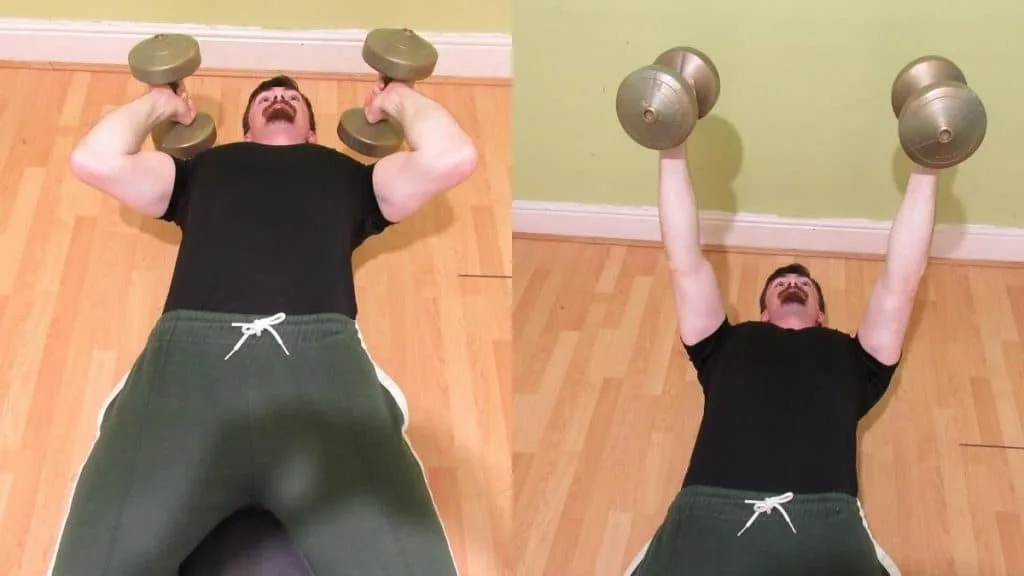
- Position a decline bench at a -15 to -30 degree angle.
- Grab a pair of dumbbells with a neutral grip.
- Sit on the decline bench and hook your feet under the foot holders if your bench has them.
- Press the weights up so that they’re directly over your face.
- Lower the dumbbells behind your head (or to the sides of your head) by breaking at your elbows.
- Descend until you feel an intense stretch in your triceps.
- Reverse the motion by flexing your triceps until your elbows reach full extension.
- Repeat for 3-5 sets of 8-20 reps.
Decline tricep extension variations
Including the dumbbell version, there are six decline lying triceps extension variations that you can perform to bulk up your arms. Each exercise, as you’ll soon learn, has its own pros and cons. So make sure to read each of these mini-guides to find out which type of decline triceps extension is best for you.
Barbell decline triceps extensions
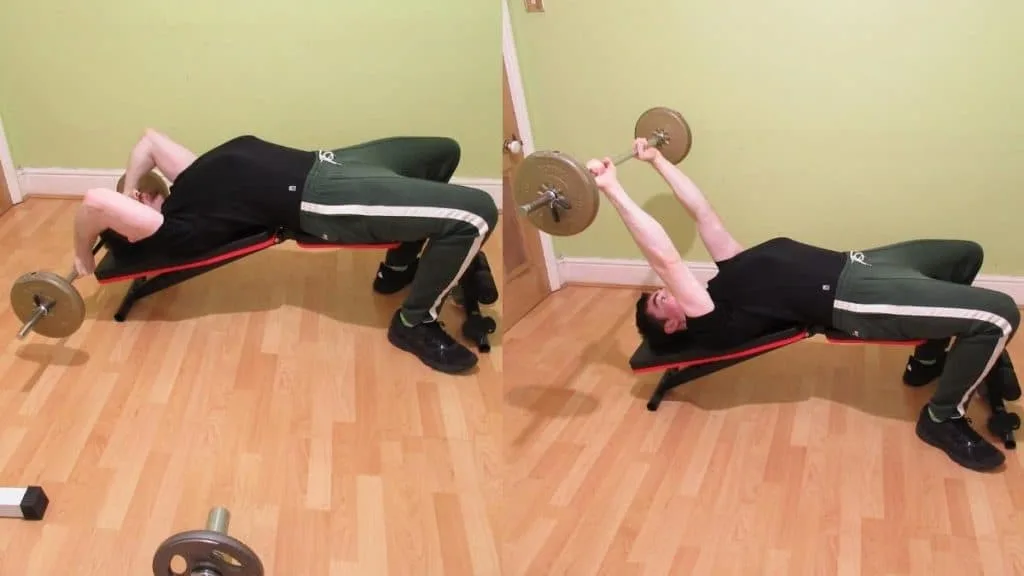
If you want to build maximum triceps mass and are willing to sacrifice some muscle symmetry for the privilege, then look no further than the decline barbell triceps extension.
This mass-building movement enables you to overload your triceps with significantly more resistance than the dumbbell version because barbells are easier to stabilize.
You can also gain strength at a faster rate with the barbell variation because the weight increments are much smaller than those of dumbbells (especially if you make use of fractional plates).
This extra strength will have excellent carryover to your compound presses (and your other DB tricep exercises) because decline tricep extensions help you to become proficient at locking out heavy weights with your triceps. So if you want to improve your bench press or overhead press lockout, the barbell decline triceps extension (or a similar variation) should be a staple exercise in your routine.
The drawback, of course, is that you’re leaving yourself open to muscle imbalances by using barbells for decline triceps extensions. It’s possible that your stronger triceps muscle will take over the movement and receive more stimulation as a result.
As such, you really want to make sure that both of your arms are applying equal force to the barbell during the exercise so that the bar doesn’t become lopsided.
EZ bar decline tricep extensions
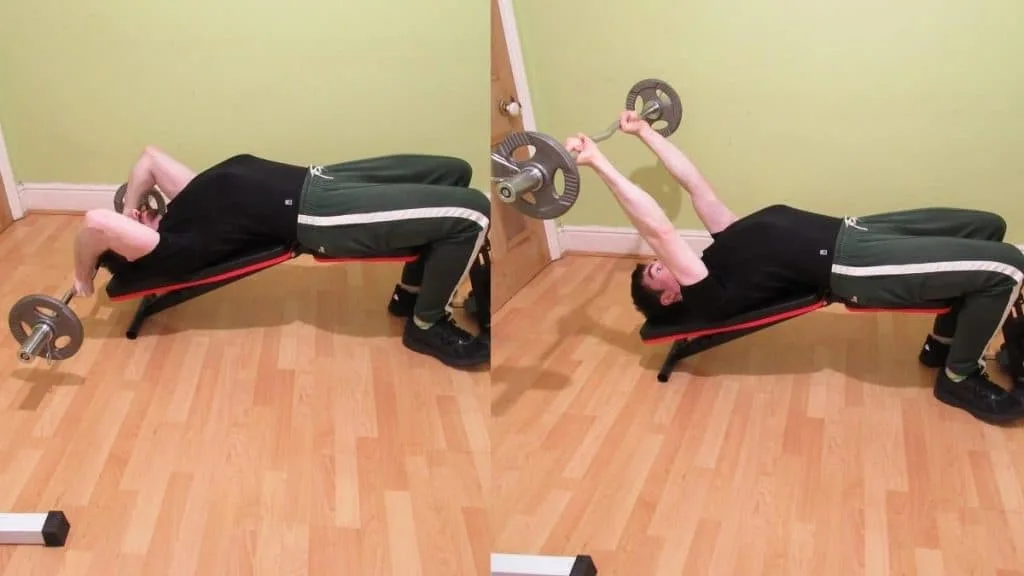
The EZ-bar decline triceps extension is essentially an optimized version of the straight bar variation that you saw above.
Yes, there’s still a chance that you’ll develop tricep size asymmetries by using an easy curl bar.
But compared to a straight bar, an EZ bar is much more comfortable to hold. This is because EZ bars have wrist-friendly semi-pronated grips, which naturally put much less pressure on your joints than the fully pronated grip offered by Olympic barbells.
Since the EZ bar is more comfortable to hold onto, especially when you’re lifting heavy, you’ll have a much easier time focusing on your triceps because you won’t have to move your hands around during the set to find a grip that doesn’t hurt your wrists.
Therefore, you’ll be able to give more attention to each of your triceps—in the form of your mind-muscle connection—to ensure that they’re receiving roughly equal amounts of work.
Cable decline triceps extension
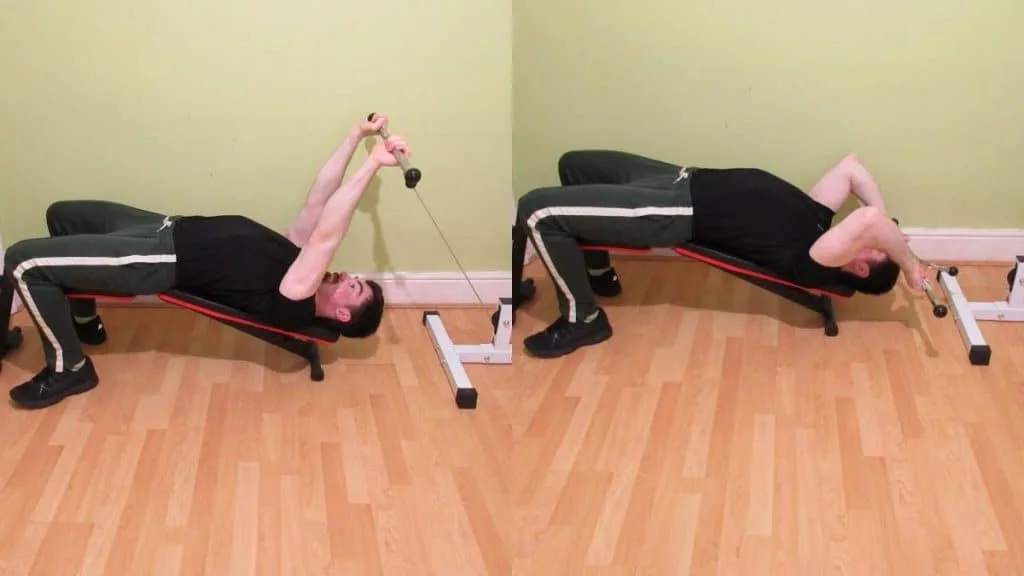
If you want to tax your triceps with constant tension and joint-friendly resistance, then the decline cable tricep extension is the exercise for you.
Sure, the setup might be a bit complicated, but the end result of a skin-splitting triceps pump will be worth the extra effort.
Unlike free-weight decline tricep extensions, the cable version challenges your triceps at every point in the rep. In other words, you can’t just rest after you’ve locked out your elbows because the pulley is still exerting some kind of force on your triceps (especially because you’re on a decline).
Similarly, since you’re using cables, you have far more exercise variety at your disposal because you can try various attachments to see which ones help you to best activate your triceps.
The rope attachment, for example, will provide a stronger peak contraction because you can spread the end of the rope to get a larger range of motion.
Opting for the bar, on the other hand, will enable you to overload your triceps with more resistance, but you won’t quite get the same intensity on the pump side of things (though the pump will still be more potent than usual because you’re using cables, which provide constant tension).
One arm decline lying triceps extension

If you want to make your triceps as symmetrical as possible, then the decline one arm lying tricep extension is where you need to focus your attention.
While dumbbell training is already a good weapon against muscular imbalances due to the fact that you’re lifting each weight independently, you can take your symmetry gains to the next level by training each arm separately.
This way, you don’t have to split your focus across two arms. It’s much easier for your brain to move one limb at a time, which means that you’ll naturally be able to channel all of your strength into giving each of your triceps the best workout possible.
While this unilateral exercise will certainly take a bit longer to perform, given that you’re training both arms separately, the extra gym time may well be worth the improvement in triceps symmetry and mind-muscle connection strength if they’re areas that you need to work on.
Alternating decline triceps extension
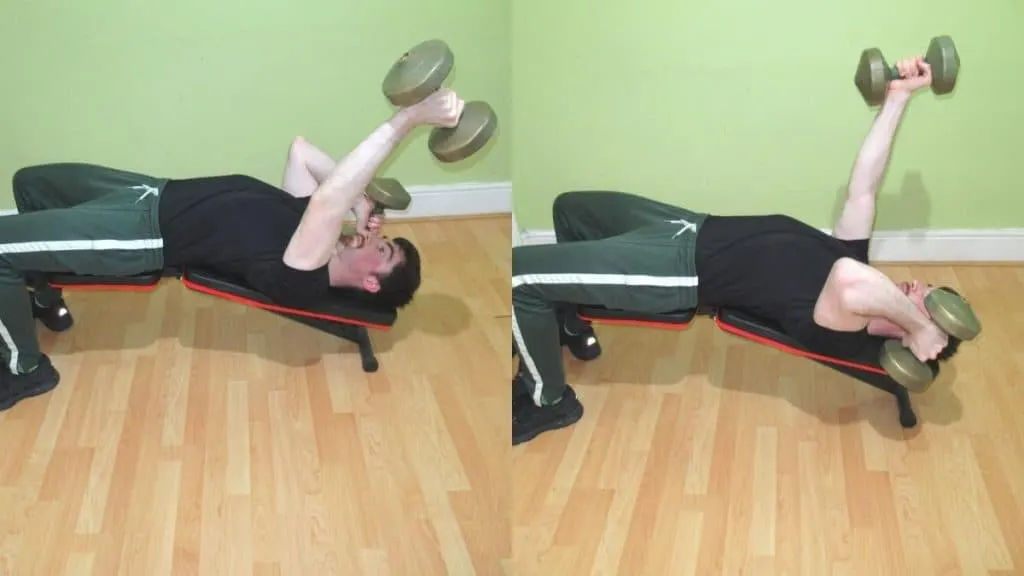
The decline alternate lying dumbbell extension lets you train both of your triceps separately without adding much extra time to your workout.
Yes, you still have to hold both weights, but you’re not actually lifting the dumbbells together; you’re raising them one at a time.
Therefore, the alternating decline DB triceps extension is an excellent exercise for building proportional arms without living in the gym.
Best of all, because each of your triceps gets a brief rest after each of its reps, your triceps will be less fatigued and thus able to perform more total reps (i.e., more training volume), which helps to stimulate more robust hypertrophy.
Decline tricep extension advantages and benefits
Compared to the flat and incline tricep extension, the decline dumbbell triceps extension, while harder to set up, offers a better eccentric muscle stretch (crucial for hypertrophy) while placing your shoulders in a more comfortable position.
Improved triceps stretch
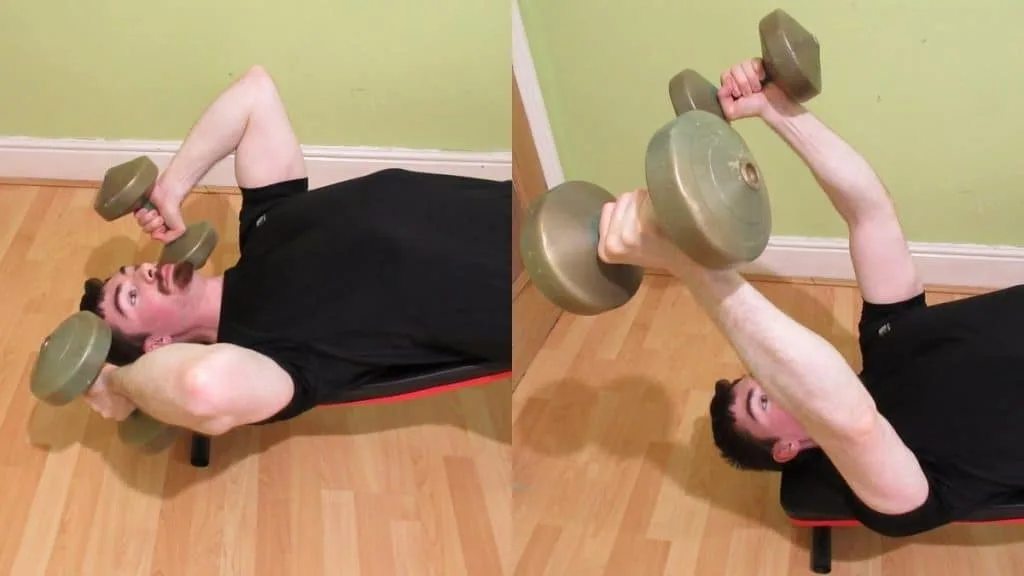
When you’re lying on a decline bench, the weights have a tendency to move backward due to gravity.
Your triceps, in fact, are the only thing that’s stopping the dumbbells from moving all the way back and eventually hitting the floor.
As such, when you perform the decline lying triceps extension rather than the flat version, your triceps get put under a greater pre-stretch (if that’s the right word) because they have to contract to prevent the weights from pulling your arms too far back.
Plus, since your arms will likely already be further back to begin with (due to the slope of the bench), the long head of your triceps, which acts on the shoulder joint as well as the elbow joint, gets put under a more intense, growth-stimulating stretch.
If you don’t have access to a decline bench but still want to enjoy a skin-splitting triceps stretch, then you can do overhead extensions using a kettlebell instead—the weighted part of the kettlebell is always trying to pull you backward, which means that your triceps have to contract extra harder to resist the backward pull.
Enhanced triceps symmetry

Muscle symmetry isn’t something that novice lifters should be overly concerned with because you need a solid foundation of mass to make any kind of symmetry apparent.
However, if you already have decent triceps development, then it can be well worth performing dumbbell exercises to reduce any size and strength asymmetries that you currently have or as a preventative measure for limiting them in the future.
Since you have to lift each dumbbell separately, you can ensure that your stronger arm doesn’t dominate the movement. This will help you to keep the bar straight (rather than letting it get lopsided) during your compound presses, which in turn will improve the transfer of your muscle strength to the bar.
Reduces your wrist discomfort
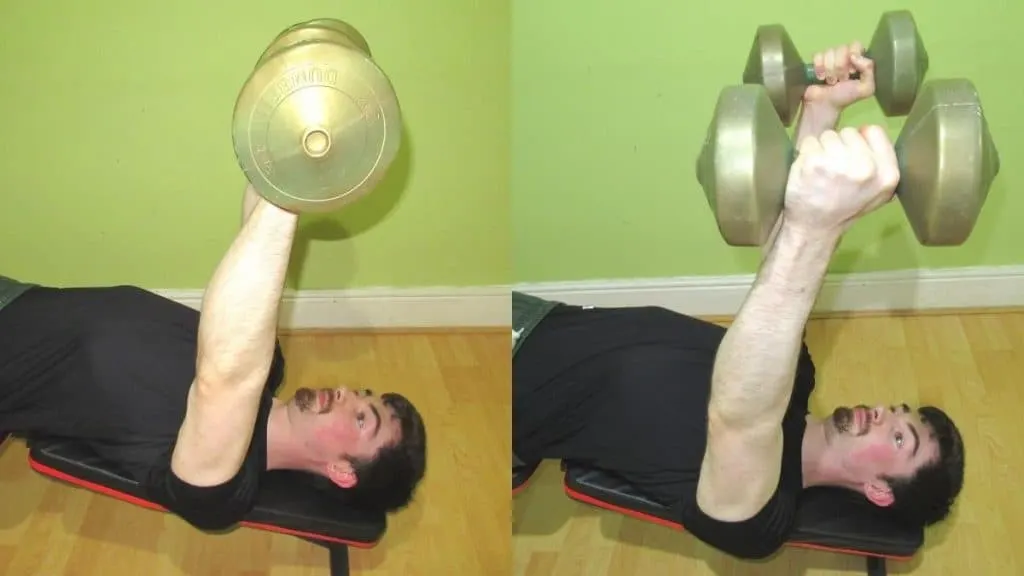
The decline DB triceps extension is a great exercise for keeping your wrists out of harm’s way because you can hold the weights with a neutral grip rather than a pronated grip.
A neutral grip is much more natural than a pronated hand position and one which enables you to gain strength without worrying if your wrists will be able to handle the extra resistance.
Decline tricep extension disadvantages and drawbacks
As effective as the decline dumbbell tricep extension is for building muscle, there are still some undeniable downsides to the exercise that you need to consider before including it in your workout routine.
Hard to get heavy weights into position
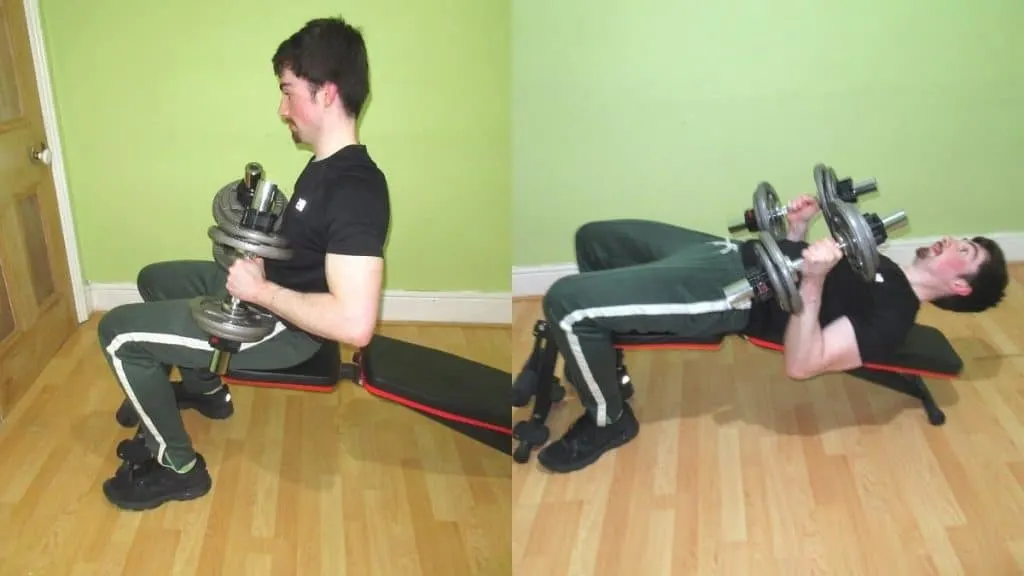
This is more an issue with barbells than dumbbells, but the problem persists nonetheless.
It’s difficult to climb onto the decline bench (especially if the slope is steep) when you have a heavy weight in your hands because you need your hands to get your body in position.
The way around this issue is to get into position first and then reach down to grab the weights, or, ideally, have someone else pass you them up.
You might feel awkward having to ask for help in getting the weights into position before every set.
So if you’d rather not ask for assistance every few minutes, then you might want to stick to the flat version.
It takes longer to set up

With regular tricep extensions, you just grab a preloaded bar, lie on a bench, and start lifting.
Training your triceps couldn’t be simpler.
But, with the decline version, you need to reach down to grab the weights or ask someone to pass you them, both of which sap your energy and time, respectively.
If you’re lifting heavy, then it’s also a good idea to use a decline bench that has a foot holder so that you don’t slide down the bench during your set.
But these kinds of benches are less common in gyms than regular adjustable benches. Heck, some gyms don’t have any such decline bench.
In the final analysis, decline dumbbell triceps extensions are a great exercise, but they can be a pain to set up if you’re lifting a decent amount of weight. You can, of course, sidestep much of the setup time by performing tricep extensions with resistance bands or by doing a plate overhead extension instead.
Requires more core stability
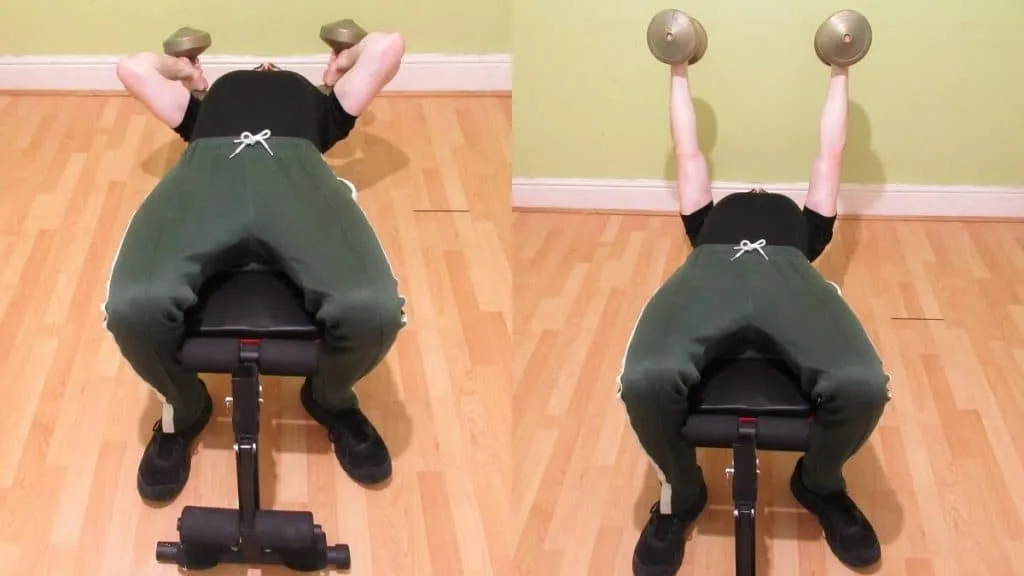
Going from sitting at the top of a decline bench to actually lying on the bench when you have weights in your hands takes a surprising amount of core strength.
This is especially true if your bench doesn’t have any foot holders to keep your torso rigid.
Exercises that demand greater core stability are usually touted as superior to those that require minimal core activation. But from a hypertrophy perspective, you could argue that the opposite is true.
After all, the clue’s in the name of the exercise. You don’t do decline dumbbell triceps extensions to work your abs; you perform them to train your triceps.
So if you want to go about things optimally, make sure that your feet are secured under a dedicated footpad or a pair of heavy dumbbells so that you’re not working your abs at the expense of your triceps.
Conclusion: How effective is the decline DB triceps extension?
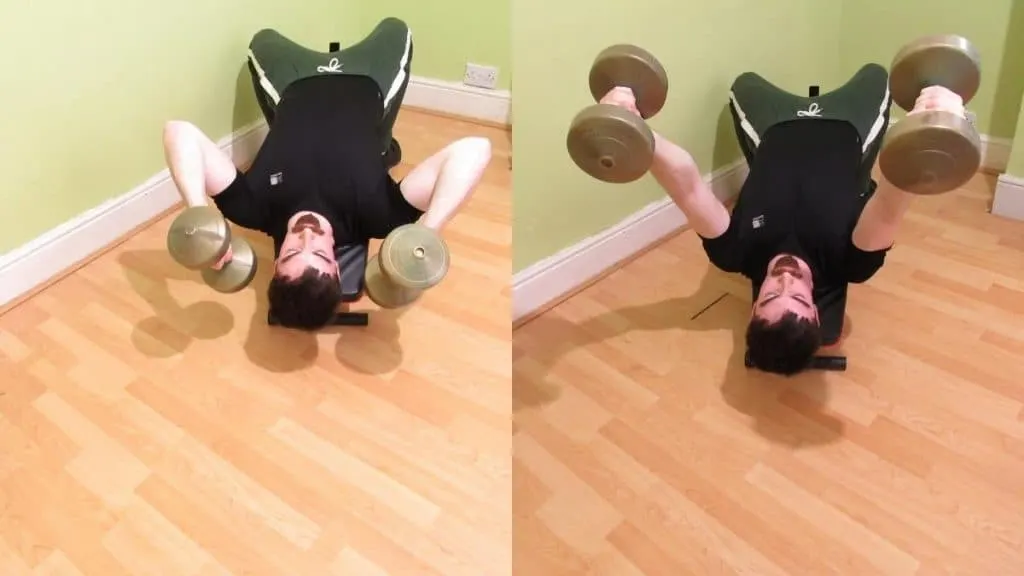
The decline dumbbell triceps extension is an effective exercise for gaining mass because it trains all three heads of the triceps while giving particular emphasis to the biggest of those heads, the long head, by putting it under a greater stretch due to the slope of the bench.
Since the shoulders are more involved in the movement in the sense that they’re positioned further back in order to stretch the long head, many lifters find that the decline tricep extension puts less pressure on their elbows than the flat bench version.

